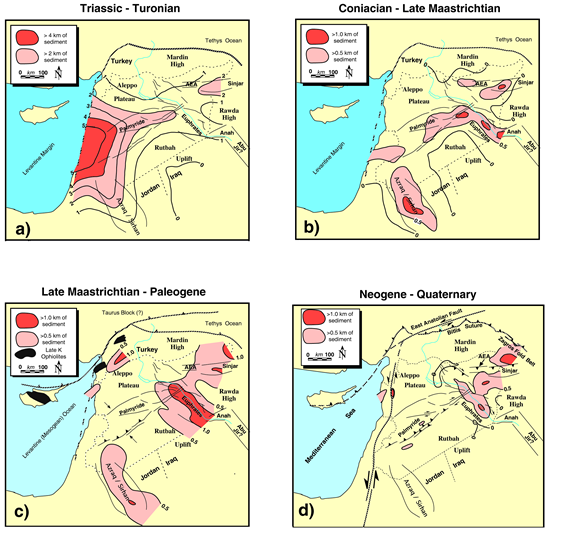
Brew, G. E., Litak, R.K., Seber, D., Barazangi, M., Sawaf, T., and Zaza, T.
The Leading Edge, 16, 1473-1482, 1997
Click here to view the published version of this paper in PDF format
This paper was published in the journal The Leading Edge by the Society of Exploration Geophysicists. SEG retains the copyright to this paper.
Brew, G. E., Litak, R. K., Seber, D., Barazangi, M., Sawaf, T., and Zaza, T., Summary of the geological evolution of Syria through geophysical interpretation: Implications for hydrocarbon exploration, The Leading Edge, 16, 1473-1482, 1997.
Click here to link to the online edition of The Leading Edge: http://www.edge-online.org/
Figure 6. Cross-section across the Euphrates graben. Location
of cross-section is shown on Figures 2 and 5. This cross-section is constrained
by seismic and well data. Note the numerous faults, with only the larger ones
shown here, demonstrating the distributed nature of deformation in the graben.
Dramatic thickening of the Upper Cretaceous strata indicates that the rifting
was most active at this time, followed by a period of Paleogene post-rift subsidence.

Figure 8. Evolution of the northern Arabian platform.
Generalized isopachs and proposed tectonic setting of Syria and surroundings
from Triassic to Recent. Present-day geography retained. AEA = Abd El Aziz.
a) Major deposition along the Levantine margin and within the Palmyride / Sinjar
trough.
b) Decreased deposition on the Levantine margin, increased deposition in the
Sinjar, southern Euphrates and Sirhan areas.
c) Collision along the northwest margin of Arabia leads to inversion of the
Palmyrides and termination of rifting in the Euphrates.
d) Full-scale collision along the northern margin leads to transpression in
the Palmyrides and Euphrates, and compression in the Sinjar and Anah areas.
